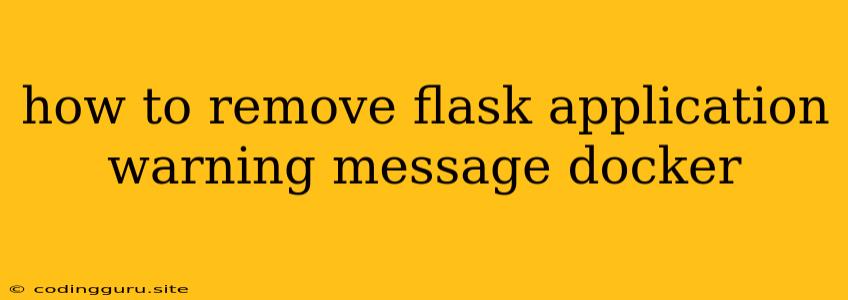How to Silence Those Pesky Flask Application Warning Messages in Docker
If you're a Flask developer who's embraced the containerization revolution with Docker, you've probably encountered those pesky warning messages that appear in your logs. These messages, often related to Flask's internal workings or external dependencies, can clutter your logs and distract from the real errors. Fortunately, there are a few techniques you can use to effectively silence these warnings while still maintaining a healthy awareness of critical issues within your Dockerized Flask application.
Understanding the Source of the Warnings
Before we dive into solutions, it's crucial to understand why Flask applications throw warnings in a Docker environment. These warnings can stem from various factors:
- Outdated Dependencies: Out-of-date libraries, particularly those used by Flask or its extensions, can sometimes trigger warnings. These warnings may point to potential security vulnerabilities or compatibility issues.
- Configuration Issues: Incorrectly configured Flask settings, such as the
DEBUGmode, can inadvertently trigger warnings that might not be relevant in a production Docker environment. - Third-Party Libraries: External libraries integrated into your Flask application might themselves throw warnings. These warnings could originate from issues within the libraries or interactions with your Flask code.
- Environment Variables: Misconfigured or missing environment variables used by your Flask application or its dependencies can lead to warnings, indicating that the application is unable to function as intended.
Strategies for Eliminating Flask Warnings in Docker
Here are some proven methods to get rid of those pesky Flask application warnings in your Docker containers:
1. Updating Dependencies:
- Use a Requirements File: The most reliable way to manage dependencies is by creating a
requirements.txtfile. This file lists all the packages your application needs, along with their specific versions. This ensures consistent and up-to-date dependencies across different environments. - Install Packages: Use the
pip install -r requirements.txtcommand within your Dockerfile to install the required packages. This ensures that you are installing the correct versions of all dependencies for your Flask application. - Check for Updates: Regularly update your
requirements.txtfile by using tools likepip freeze > requirements.txtto capture the current installed versions. This ensures that you have the latest, potentially bug-fixed versions of your dependencies.
2. Configure Flask Settings:
- Set DEBUG Mode: In a production Docker environment, you should generally set
DEBUGtoFalse. This disables debugging features that can contribute to warnings and improve performance. - Logging Levels: Use the
loggingmodule in your Flask application to control the level of log messages. By default, Flask logs warnings. You can adjust the level toINFOorERRORto suppress warnings.
3. Suppress Warnings from Third-Party Libraries:
- Import Warnings: Import the
warningsmodule in your Flask application. This module provides functions for filtering and ignoring warnings. - Filter Warnings: Use the
warnings.filterwarnings()function to filter warnings from specific libraries or with certain warning codes. This allows you to suppress warnings while still potentially catching critical errors.
4. Environment Variables:
- Set Environment Variables: Ensure that all the environment variables required by your Flask application and its dependencies are properly defined in your Dockerfile using the
ENVinstruction. - Docker Environment Variables: Use Docker environment variables to provide sensitive information like database credentials or API keys securely.
5. Debugging Techniques:
- Logging: Use logging statements within your Flask code to pinpoint the source of warnings. This can help you identify which parts of your code or which libraries are causing the issues.
- Docker Logs: Inspect the logs generated by your Docker container. The logs often contain details about warnings, including the library causing the warning and the code line where it originated. This can help you identify the source of warnings.
- Docker Exec: Use the
docker execcommand to run commands inside your running Docker container. This can be helpful for troubleshooting problems by interactively running your Flask application within the container environment.
Example: Configuring Logging Levels in Flask
import logging
app = Flask(__name__)
# Configure logging to suppress warnings and only log errors
logging.basicConfig(level=logging.ERROR)
# Your Flask application code here
Note: While suppressing warnings can help you focus on more important messages, it's crucial to understand the potential risks associated with hiding warnings. Warnings can sometimes indicate potential issues that might eventually lead to errors. Therefore, carefully consider which warnings you want to suppress and make sure you're not masking critical information.
Conclusion
By implementing these strategies, you can effectively remove those pesky Flask application warning messages from your Docker logs. This will help you maintain cleaner logs, improve the readability of error messages, and focus on the true problems within your application. Remember to prioritize code quality, dependency updates, and proper configuration to build robust and reliable Flask applications in a Docker environment.
This will not only help you achieve your desired results but also make your development process more efficient and enjoyable.
